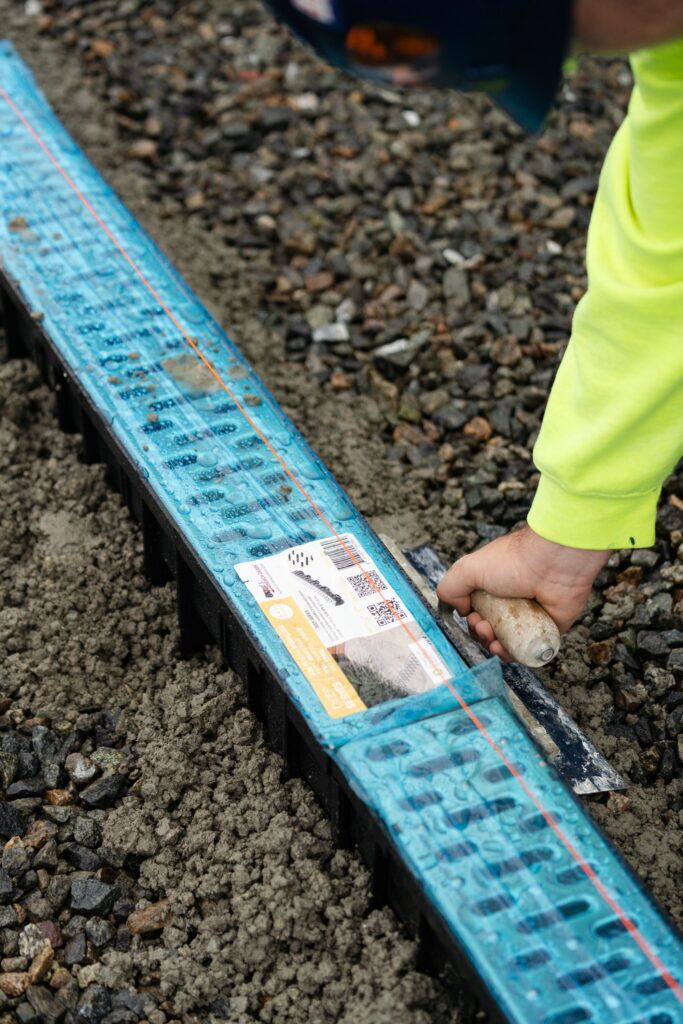
‘Toxic’ work environment at the largest U.S. feminist group prompts president to leave
May 14, 2025
Trump’s Prized Tax Bill Doesn’t Do Anything He Promised
May 14, 2025The administration has revoked executive orders encouraging the hiring of women and cut funding for groups dedicated to helping female workers enter the trades.
Two years into Stephanie Stachura’s apprenticeship as an electrician in Chicago, she saw something she had never seen before: another woman working on the job site.
“I had a fangirl moment because I was just in awe of her,” Stachura said. “She was older and had been in it since she was younger.”
Stachura’s surprise stemmed from the fact that women make up a tiny proportion of workers in skilled construction trades in the United States. Just 2.7 percent of electricians in the country are women.
Five years later, she’s still friends with the journeywoman she saw that day. Meeting her helped Stachura overcome the nervousness she felt as a newbie and a woman in a nearly all-male profession. They still talk with each other about their experiences on job sites, she said.
“A tradeswoman who has done her time?” Stachura said. “That is a badass … and I just want to be around her.”
Despite making up 47 percent of the workforce in the U.S., women constitute less than 5 percent of workers in skilled construction trades—a cluster of careers that typically offer high pay without requiring a college degree. The few women who land apprenticeships in a skilled trade often face bullying, harassment and low-level work opportunities.
In recent years, nonprofit groups offering “pre-apprenticeships” and other programs designed to improve female representation in the trades have made some progress in changing the culture of construction worksites and improving access for women, nearly doubling the share of women in skilled trades from less than 3 percent to about 5 percent in the past decade. Now, advocates say those efforts are under threat from the Trump administration’s attacks on diversity, equity and inclusion.
A day after his inauguration in January, President Donald Trump revoked several decades-old executive orders designed to diversify the workforce, in an attempt to root out what he called “immoral race- and sex-based preferences under the guise of so-called diversity, equity, and inclusion.” Among them was Executive Order 11246. Issued in 1965 by President Lyndon B. Johnson, the order required federal contractors to provide equal employment opportunity without discriminating by race.
In 1978, the Office of Federal Contract Compliance issued a goal that took the order a step further. Contractors had to make a good faith effort to hire women to fill at least 6.9 percent of their positions in construction. That figure, which hasn’t been updated in 45 years, was based on the share of women in the workforce in the 1970s.
While that goal has never been met industrywide, the executive order paved the way for the creation of pre-apprenticeship programs—short-term training that introduces women to careers in the trades. With that order revoked, construction employers who receive federal dollars are now freed from having to show they’re making an effort to hire women or underrepresented groups.
Along with arguing that equity initiatives are illegal, Trump also signed two anti-DEI executive orders directing federal agencies to cancel funding for any programs that include diversity, equity or inclusion in their operations.
In May, the Trump administration canceled a major grant for groups helping women get jobs in trades, along with several other grants that supported programs seeking to prevent sexual harassment.
And the two agencies that historically investigated harassment or discrimination claims on job sites—the Office of Federal Contract Compliance and the Equal Employment Opportunity Commission—have published statements about their new focus on investigating “DEI practices.” (The EEOC declined a request to comment and the Office of Federal Contract Compliance did not respond.)
Confusion about what exactly the Trump administration means by the phrase “illegal DEI” in those orders has left nonprofit leaders puzzled.
“It is really ill-defined in these executive orders what exactly ‘illegal DEI’ is, and so it leaves everyone in limbo a little bit about what they can and can’t do,” said Jayne Vellinga, executive director of Chicago Women in Trades, a nonprofit group dedicated to supporting women in the workforce. If a program “is designed around achieving equity for a group of people, does that mean that it’s across the board illegal?”
In February, Chicago Women in Trades sued, saying the administration’s actions threaten the nonprofit’s existence and its right to free speech. Federal money makes up about 40 percent of the group’s budget—losing it would drastically reduce its operations.
Most of the federal funding going to groups like Chicago Women in Trades comes from the Apprenticeship Building America grant program, which was created by the Biden administration and included $50 million in grants to “support equity partnerships and pre-apprenticeship activities” to boost enrollment of underrepresented groups in registered apprenticeships. Another federal funding source is WANTO—the Women in Apprenticeship and Nontraditional Occupations program—which has been around since 1992 and last year gave out $6 million to nine groups that work to increase opportunities for women.
Trump cut WANTO and about two dozen other grants that boosted women’s representation in careers and addressed sexual harassment at worksites, from his 2026 budget released in May, Mother Jones first reported.
Chicago Women in Trades was excluded from the cuts because of the group’s lawsuit.
In April, a federal judge ordered a preliminary injunction preventing the Trump administration from pausing funding for the organization based on the anti-DEI executive orders while the group’s lawsuit moves through the courts.
Other grantees decried the cuts. Maisie Howard, director of development and communications at Vermont Works for Women, said her group was notified in a May 6 letter of the immediate cancellation of a two-year, $400,000 WANTO grant it received last year. The letter said the grant does not align with the Department of Labor’s priorities “with regard to diversity, equity, inclusion, and accessibility.”
Most tradeswomen would tell you that they have to be more, not less, qualified than men to work even half as much.
Jayne Vellinga
Vermont Works for Women was planning to use a portion of the federal funds to start a new program training women for advanced manufacturing fields, such as working in semiconductor plants.
“It was a big deal for Vermont to be able to get this funding in the first place,” Howard said. “It was a big blow.”
Nonprofits are worried that the hostility at the federal level toward gender- and race-based programs will put local money at risk as well. Since the administration is threatening to cancel funding for groups that promote diversity, equity and inclusion, local and state entities that rely on federal dollars could be tempted to pull back donations to pre-apprenticeship groups to protect themselves, trade groups say.
Fear of retribution has led some nonprofits to change the language on their websites and in their materials to remove words the administration might target, according to a review of nonprofit organization websites. Before the injunction, some groups had been threatening to cancel their contracts with Chicago Women in Trades, adding to the organization’s “pressure to self-censor its speech,” the court order said.
The Painters District Council No. 30—a labor organization representing painters, finishers and glaziers in central Illinois—is about 5 percent female, said Marisa Richards, the council’s director of outreach and engagement. The group is trying to change that by focusing on making job sites safer for women through harassment training. That work isn’t changing, but they’re reconsidering using the words “diversity, equity and inclusion” when they talk about their efforts.
“We’re trying to make sure that we avoid those phrases because they can be triggering or isolating, and then it just changes the conversation,” Richards said. “We’re still highlighting the diversity, without specifically calling it diversity.”
The mission statement of Utah Women in Trades—to increase the “number of women pursuing and succeeding in non-traditional building and construction trades”—has not changed, but welding instructor and group vice president Nicci Navarro said she feels more cautious about how she presents her classes with sexual harassment and discrimination training. The Civil Rights Act is still law—it is illegal for employers to discriminate based on race or sex, even if the executive order enforcing it in the construction industry is gone. She’s careful to cite that law when she presents the HR training.
“I make sure to explain that to my students,” Navarro said. “We have to talk about diversity, we have to talk about sexual harassment.”
Despite having “women” in its name, Utah Women in Trades has had recent graduating classes that are about one-quarter men, Navarro said. Still, the group is concerned that having “women” in its title could mean it runs afoul of the Trump administration’s anti-DEI crusade.
There’s another long-term worry: The culture these groups have worked so hard to change might shift. When women graduate from the pre-apprenticeship programs and enter the workforce, will their job sites be safe places to work?
Even as more women enter construction jobs, bullying, sexual harassment and discrimination remain rampant in the industry.
In 2021, more than one in four women in these trades reported “always” or “frequently” being harassed on the job, according to a survey of more than 2,600 people by the Institute for Women’s Policy Research.
A 2023 report by the Equal Employment Opportunity Commission said some of the “most egregious instances of harassment and discrimination” the agency has ever investigated were in the construction industry. Three days into President Donald Trump’s second term, that report was removed from the EEOC website.
Women also report fewer opportunities to learn high-quality skills during their apprenticeships. They may be assigned to count screws or complete tasks that are simple and repetitive compared to duties given to their male counterparts, said Ariane Hegewisch, senior research fellow at the Institute for Women’s Policy Research—something that could hinder their future job prospects.
The pre-apprenticeship programs don’t guarantee a job, but they help women learn what’s necessary to apply for an apprenticeship. Sometimes, the programs help cover initial expenses for tool kits or child care. In the end, it’s up to each student to carve a path into the trades.
“It has not been my experience, in the many years that I have worked here, that unqualified women have gotten jobs over qualified men,” Vellinga said. “Most tradeswomen would tell you that they have to be more, not less, qualified than men to work even half as much.”
In December, the Illinois chapter of the AFL-CIO passed a resolution to increase the ratio of women in construction trades from about 5 percent to 20 percent by 2029. Part of that goal includes an annual meeting to assess best practices and whether member unions are making progress. Trump’s executive orders haven’t changed that goal, chapter president Tim Drea said.
“We’ll roll with the punches coming out of Washington. We’re just going to keep moving forward,” Drea said.
Because women typically have less exposure to shop classes and fewer opportunities to learn how to use tools at a young age compared to men, women who go through the program often do so later in life as a career change.
Some women, like Stachura, said they simply hadn’t known it was an option for them.
“Nobody in my family was ever like, ‘Oh, you should go into a trade.’ That was never a conversation that happened,” Stachura said.
Stachura, an electrician in the Chicago area for seven years now, learned about Chicago Women in Trades when she was 33 and a single mom to three children. She was in the process of going back to college for nursing when she saw a social media post from a friend describing how she was making decent money after finishing the pre-apprenticeship program.
Being able to earn enough money to support her children without taking on student loan debt appealed to Stachura, as did the idea of working with her hands. She dropped out of nursing school and enrolled in Chicago Women in Trades. Along with studying for an apprenticeship test, she started going to the gym to make sure she could lift heavy objects.
At the end of the program, Stachura said, she scored in the top 5 percent of applicants seeking an electrical apprenticeship in the Chicago area that cycle.
By the time she completed her apprenticeship in 2023 and became a journeywoman electrician, Stachura was making a six-figure salary—at least three times more than she had ever earned before.
“I went from struggling to pay bills and worrying about where I was going to get the money from for groceries to being able to volunteer on the weekend because I have the capacity to do for others,” Stachura said.
The pre-apprenticeship program opened the door to that opportunity, she said. The classes she attended not only taught her how to use different tools and prepare for the apprenticeship test, it also gave her a chance to hear from women who had years of experience working in various trades. It’s what helped her realize she wanted to be an electrician.
“It literally changed the trajectory of my life and it changed the trajectory of my children’s lives,” she said.
Now, Stachura is a superintendent at the construction company where she works, as well as vice president of her local’s chapter of the Sisters of International Brotherhood of Electrical Workers. When she comes across other women on the job site, she wants them to feel inspired like she once was.
Eventually, she hopes the surprise will fade, too.
This story about tradeswomen was produced by The Hechinger Report, a nonprofit, independent news organization focused on inequality and innovation in education. Sign up for the Hechinger newsletter.
Contact reporter Ariel Gilreath at gilreath@hechingerreport.org or on Signal at arielgilreath.46.
Great Job Ariel Gilreath, The Hechinger Report & the Team @ Ms. Magazine Source link for sharing this story.







